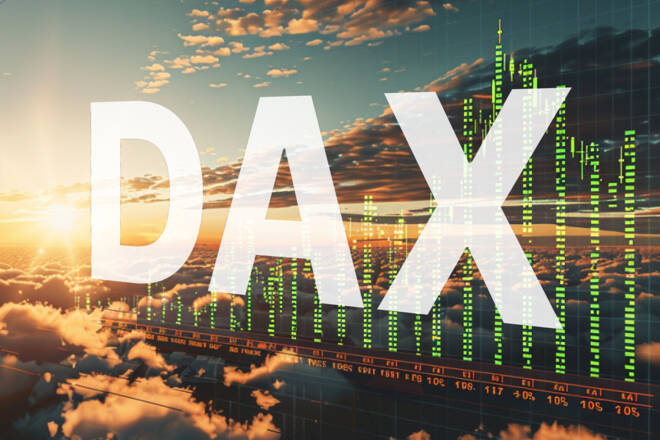Advertisement
Advertisement
Dax Index News: DAX Faces Risk with Weaker China PMIs and US-EU Trade Tensions
By:
Key Points:
- DAX slipped by 0.08% on January 24, ending a seven-day rally after striking a record high of 21,521 before a late pullback.
- US tariff threats and rising input prices dampen hopes for aggressive ECB rate cuts despite better PMI data.
- Fed hawkish stance looms as January’s services inflation surges, complicating rate cut expectations for H1 2025.
In this article:
DAX Ends Seven-Day Winning Streak
On Friday, January 24, the DAX slipped by 0.08%, partially reversing Thursday’s 0.74% gain to close at 21,395. Despite striking a record high of 21,521, a late pullback ended a seven-day winning streak.
German private sector data signaled a steadying in the economy, tempering expectations of aggressive ECB rate cuts. Meanwhile, US tariff threats lingered despite President Trump’s latest pivot on China.
Sector Highlights: Autos and Retailers Shine
Online retailer Zalando rallied 2.92% on January 24, buoyed by Burberry’s better-than-expected Q3 sales data.
Hopes of the EU negotiating its way out of US tariffs boosted demand for auto stocks. Porsche advanced by 2.70%, while BMW and Mercedes-Benz Group rose 1.89% and 1.74%, respectively. Volkswagen and Daimler Truck Holding also posted gains.
However, MTU Aero Engines tumbled 6.52% on profit-taking following Boeing’s (BA) warnings of larger-than-expected Q4 losses.
German Private Sector Stabilizes
Germany’s HCOB Services PMI increased from 51.2 in December to 52.5 in January, while the manufacturing sector contracted at a less marked pace. The better-than-expected PMI readings led the Composite PMI to a seven-month high of 50.1, signaling a return to expansion.
Input and output prices accelerated in January, impacting hopes for significant ECB policy easing.
Dr. Cyrus de la Rubia highlighted that the German economy shows signs of recovery, with the Composite PMI crossing 50 for the first time since early summer, signaling expansion. He attributed this improvement to a stronger services sector and easing recessionary pressures in manufacturing. However, he noted that the manufacturing sector’s performance will depend on US tariff actions and the German government’s policy measures post-February elections.
German Business Sentiment in Focus
On Monday, January 27, Germany’s Ifo Business Climate Index will take center stage. Economists expect the Index to slip from 84.7 in December to 84.6 in January.
A larger-than-expected decline could test market optimism toward a potential German economic recovery. Weaker sentiment may impact the labor market and consumer-driven consumption. A pullback in consumption may dampen demand-driven inflationary pressures, supporting a more dovish ECB rate path.
Conversely, an unexpected increase could reduce ECB rate cuts bets to bolster the Euro area economy.
US Services Sector Inflation Tests Fed Rate Cut Bets
On January 24, the US S&P Global Services PMI fell from 56.8 in December to 52.8 in January. While adverse weather affected demand, rising costs were a key factor.
The January survey revealed that services sector inflation rose at the most marked pace since September. As the key contributor to US inflation, The trends observed in January could signal a more hawkish Fed rate path. Higher borrowing costs may affect company earnings and valuations.
US Markets Retreat on Mixed Economic Data
US equity markets posted losses at the end of the week as investors reacted to the US economic calendar. The Nasdaq Composite Index fell 0.50%, while the Dow and the S&P 500 declined by 0.32% and 0.29%, respectively.
US Economic Calendar: Dallas and Chicago Fed Data in Focus
On January 27, the Chicago Fed National Activity Index and Dallas Fed Manufacturing Index will give further insights into the US economy. Economists expect the Indexes to move higher, supporting a more hawkish Fed rate path.
Fading bets on an H1 2025 Fed rate cut amid fears that US tariffs fueling inflationary pressures could impact German stocks.
Conversely, weaker-than-expected data and easing tariff rhetoric could boost risk sentiment.
Near-Term Outlook
The DAX’s performance will hinge on the ECB and Fed interest rate decisions and forward guidance. An ECB rate cut and support for further rate cuts could drive the DAX toward 22,000, while a hawkish ECB rate cut could impact risk sentiment.
However, the Fed could overshadow Thursday’s ECB policy decision if it signals a near-term hold on interest rates. A more hawkish Fed rate path could pull the DAX below 21,000.
External factors, such as potential stimulus from Beijing and US-EU trade negotiations, will also play a role. Chinese stimulus could support German exports, though US tariffs may counteract this benefit.
As of Monday morning, futures signaled a potential market sell-off. DAX futures were down 89 points, while the Nasdaq 100 mini tumbled by 430 points. Weak private sector PMIs from China and news of China’s AI platform DeepSeek surpassing ChatGPT on Apple’s app download rankings pressured the futures markets.
DAX Technical Indicators
Daily Chart
Despite Friday’s retreat, the DAX sits well above the 50-day and 200-day Exponential Moving Averages (EMAs), affirming bullish price signals.
A breakout from the January 24 record high of 21,521 could signal a move above 21,750. A break above 21,750 may bring the 22,000 level into sight.
Conversely, a DAX drop to 21,350 may enable the bears to target 21,000, a key support level.
With the 14-day Relative Strength Index (RSI) at 78.55, the DAX remains in overbought territory (RSI higher than 70). Selling pressure could intensify at Friday’s record high of 21,521.
Conclusion: Key Drivers to Watch
Traders should focus on the ECB, the Fed, and US tariff developments. External factors, including Chinese economic policies, could further influence the DAX.
Read our detailed analysis of how global market dynamics influence the DAX’s performance here.
About the Author
Bob Masonauthor
With over 28 years of experience in the financial industry, Bob has worked with various global rating agencies and multinational banks. Currently he is covering currencies, commodities, alternative asset classes and global equities, focusing mostly on European and Asian markets.
Latest news and analysis
Advertisement
